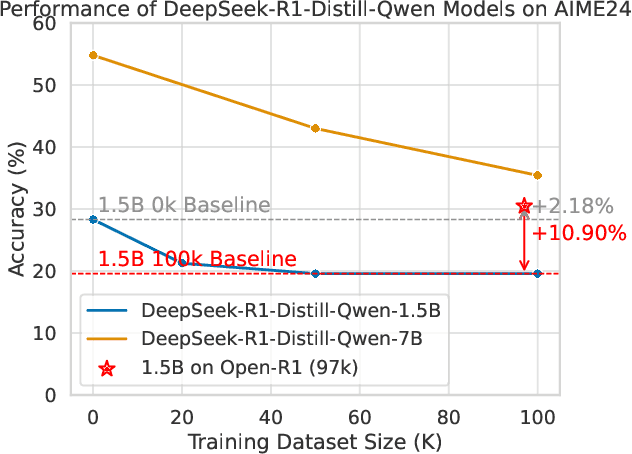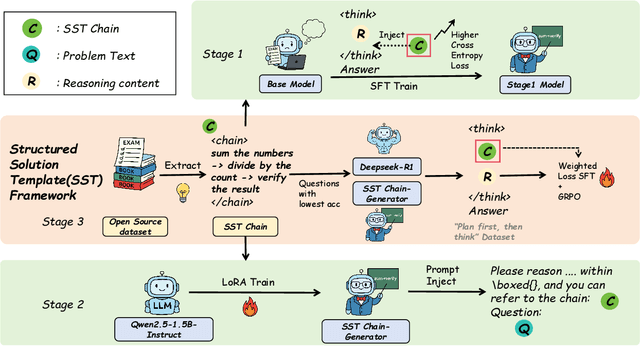Yifan Sun
Can Structured Templates Facilitate LLMs in Tackling Harder Tasks? : An Exploration of Scaling Laws by Difficulty
Aug 26, 2025



Abstract:Structured, procedural reasoning is essential for Large Language Models (LLMs), especially in mathematics. While post-training methods have improved LLM performance, they still fall short in capturing deep procedural logic on complex tasks. To tackle the issue, in this paper, we first investigate this limitation and uncover a novel finding: a Scaling Law by Difficulty, which reveals that model performance follows a U-shaped curve with respect to training data complexity -- excessive low-difficulty data impedes abstraction, while high-difficulty data significantly enhances reasoning ability. Motivated by this, we propose the Structured Solution Template (SST) framework, which uses solution templates and a curriculum of varied difficulty to explicitly teach procedural reasoning. Specifically, SST comprises (1) fine-tuning with structured solution-template chains and dynamically weighted loss to prioritize procedural logic, (2) prompt-time injection of solution templates as cognitive scaffolds to guide inference, and (3) integrated curriculum fine-tuning that explicitly teaches the model to self-plan - execute - self-correct. Experiments on GSM8K, AIME24, and new Dynamic En benchmark show that SST significantly improves both accuracy and efficiency, especially on harder problems.
CoST: Efficient Collaborative Perception From Unified Spatiotemporal Perspective
Aug 01, 2025Abstract:Collaborative perception shares information among different agents and helps solving problems that individual agents may face, e.g., occlusions and small sensing range. Prior methods usually separate the multi-agent fusion and multi-time fusion into two consecutive steps. In contrast, this paper proposes an efficient collaborative perception that aggregates the observations from different agents (space) and different times into a unified spatio-temporal space simultanesouly. The unified spatio-temporal space brings two benefits, i.e., efficient feature transmission and superior feature fusion. 1) Efficient feature transmission: each static object yields a single observation in the spatial temporal space, and thus only requires transmission only once (whereas prior methods re-transmit all the object features multiple times). 2) superior feature fusion: merging the multi-agent and multi-time fusion into a unified spatial-temporal aggregation enables a more holistic perspective, thereby enhancing perception performance in challenging scenarios. Consequently, our Collaborative perception with Spatio-temporal Transformer (CoST) gains improvement in both efficiency and accuracy. Notably, CoST is not tied to any specific method and is compatible with a majority of previous methods, enhancing their accuracy while reducing the transmission bandwidth.
Proto-EVFL: Enhanced Vertical Federated Learning via Dual Prototype with Extremely Unaligned Data
Jul 30, 2025Abstract:In vertical federated learning (VFL), multiple enterprises address aligned sample scarcity by leveraging massive locally unaligned samples to facilitate collaborative learning. However, unaligned samples across different parties in VFL can be extremely class-imbalanced, leading to insufficient feature representation and limited model prediction space. Specifically, class-imbalanced problems consist of intra-party class imbalance and inter-party class imbalance, which can further cause local model bias and feature contribution inconsistency issues, respectively. To address the above challenges, we propose Proto-EVFL, an enhanced VFL framework via dual prototypes. We first introduce class prototypes for each party to learn relationships between classes in the latent space, allowing the active party to predict unseen classes. We further design a probabilistic dual prototype learning scheme to dynamically select unaligned samples by conditional optimal transport cost with class prior probability. Moreover, a mixed prior guided module guides this selection process by combining local and global class prior probabilities. Finally, we adopt an \textit{adaptive gated feature aggregation strategy} to mitigate feature contribution inconsistency by dynamically weighting and aggregating local features across different parties. We proved that Proto-EVFL, as the first bi-level optimization framework in VFL, has a convergence rate of 1/\sqrt T. Extensive experiments on various datasets validate the superiority of our Proto-EVFL. Even in a zero-shot scenario with one unseen class, it outperforms baselines by at least 6.97%
RoboPARA: Dual-Arm Robot Planning with Parallel Allocation and Recomposition Across Tasks
Jun 07, 2025Abstract:Dual-arm robots play a crucial role in improving efficiency and flexibility in complex multitasking scenarios. While existing methods have achieved promising results in task planning, they often fail to fully optimize task parallelism, limiting the potential of dual-arm collaboration. To address this issue, we propose RoboPARA, a novel large language model (LLM)-driven framework for dual-arm task parallelism planning. RoboPARA employs a two-stage process: (1) Dependency Graph-based Planning Candidates Generation, which constructs directed acyclic graphs (DAGs) to model task dependencies and eliminate redundancy, and (2) Graph Re-Traversal-based Dual-Arm Parallel Planning, which optimizes DAG traversal to maximize parallelism while maintaining task coherence. In addition, we introduce the Cross-Scenario Dual-Arm Parallel Task dataset (X-DAPT dataset), the first dataset specifically designed to evaluate dual-arm task parallelism across diverse scenarios and difficulty levels. Extensive experiments on the X-DAPT dataset demonstrate that RoboPARA significantly outperforms existing methods, achieving higher efficiency and reliability, particularly in complex task combinations. The code and dataset will be released upon acceptance.
NeSyPack: A Neuro-Symbolic Framework for Bimanual Logistics Packing
Jun 06, 2025Abstract:This paper presents NeSyPack, a neuro-symbolic framework for bimanual logistics packing. NeSyPack combines data-driven models and symbolic reasoning to build an explainable hierarchical system that is generalizable, data-efficient, and reliable. It decomposes a task into subtasks via hierarchical reasoning, and further into atomic skills managed by a symbolic skill graph. The graph selects skill parameters, robot configurations, and task-specific control strategies for execution. This modular design enables robustness, adaptability, and efficient reuse - outperforming end-to-end models that require large-scale retraining. Using NeSyPack, our team won the First Prize in the What Bimanuals Can Do (WBCD) competition at the 2025 IEEE International Conference on Robotics and Automation.
Improving Data Efficiency for LLM Reinforcement Fine-tuning Through Difficulty-targeted Online Data Selection and Rollout Replay
Jun 05, 2025Abstract:Reinforcement learning (RL) has become an effective approach for fine-tuning large language models (LLMs), particularly to enhance their reasoning capabilities. However, RL fine-tuning remains highly resource-intensive, and existing work has largely overlooked the problem of data efficiency. In this paper, we propose two techniques to improve data efficiency in LLM RL fine-tuning: difficulty-targeted online data selection and rollout replay. We introduce the notion of adaptive difficulty to guide online data selection, prioritizing questions of moderate difficulty that are more likely to yield informative learning signals. To estimate adaptive difficulty efficiently, we develop an attention-based framework that requires rollouts for only a small reference set of questions. The adaptive difficulty of the remaining questions is then estimated based on their similarity to this set. To further reduce rollout cost, we introduce a rollout replay mechanism that reuses recent rollouts, lowering per-step computation while maintaining stable updates. Extensive experiments across 6 LLM-dataset combinations show that our method reduces RL fine-tuning time by 25% to 65% to reach the same level of performance as the original GRPO algorithm.
MiCRo: Mixture Modeling and Context-aware Routing for Personalized Preference Learning
May 30, 2025Abstract:Reward modeling is a key step in building safe foundation models when applying reinforcement learning from human feedback (RLHF) to align Large Language Models (LLMs). However, reward modeling based on the Bradley-Terry (BT) model assumes a global reward function, failing to capture the inherently diverse and heterogeneous human preferences. Hence, such oversimplification limits LLMs from supporting personalization and pluralistic alignment. Theoretically, we show that when human preferences follow a mixture distribution of diverse subgroups, a single BT model has an irreducible error. While existing solutions, such as multi-objective learning with fine-grained annotations, help address this issue, they are costly and constrained by predefined attributes, failing to fully capture the richness of human values. In this work, we introduce MiCRo, a two-stage framework that enhances personalized preference learning by leveraging large-scale binary preference datasets without requiring explicit fine-grained annotations. In the first stage, MiCRo introduces context-aware mixture modeling approach to capture diverse human preferences. In the second stage, MiCRo integrates an online routing strategy that dynamically adapts mixture weights based on specific context to resolve ambiguity, allowing for efficient and scalable preference adaptation with minimal additional supervision. Experiments on multiple preference datasets demonstrate that MiCRo effectively captures diverse human preferences and significantly improves downstream personalization.
Enhancing the Comprehensibility of Text Explanations via Unsupervised Concept Discovery
May 26, 2025Abstract:Concept-based explainable approaches have emerged as a promising method in explainable AI because they can interpret models in a way that aligns with human reasoning. However, their adaption in the text domain remains limited. Most existing methods rely on predefined concept annotations and cannot discover unseen concepts, while other methods that extract concepts without supervision often produce explanations that are not intuitively comprehensible to humans, potentially diminishing user trust. These methods fall short of discovering comprehensible concepts automatically. To address this issue, we propose \textbf{ECO-Concept}, an intrinsically interpretable framework to discover comprehensible concepts with no concept annotations. ECO-Concept first utilizes an object-centric architecture to extract semantic concepts automatically. Then the comprehensibility of the extracted concepts is evaluated by large language models. Finally, the evaluation result guides the subsequent model fine-tuning to obtain more understandable explanations. Experiments show that our method achieves superior performance across diverse tasks. Further concept evaluations validate that the concepts learned by ECO-Concept surpassed current counterparts in comprehensibility.
The Staircase of Ethics: Probing LLM Value Priorities through Multi-Step Induction to Complex Moral Dilemmas
May 23, 2025Abstract:Ethical decision-making is a critical aspect of human judgment, and the growing use of LLMs in decision-support systems necessitates a rigorous evaluation of their moral reasoning capabilities. However, existing assessments primarily rely on single-step evaluations, failing to capture how models adapt to evolving ethical challenges. Addressing this gap, we introduce the Multi-step Moral Dilemmas (MMDs), the first dataset specifically constructed to evaluate the evolving moral judgments of LLMs across 3,302 five-stage dilemmas. This framework enables a fine-grained, dynamic analysis of how LLMs adjust their moral reasoning across escalating dilemmas. Our evaluation of nine widely used LLMs reveals that their value preferences shift significantly as dilemmas progress, indicating that models recalibrate moral judgments based on scenario complexity. Furthermore, pairwise value comparisons demonstrate that while LLMs often prioritize the value of care, this value can sometimes be superseded by fairness in certain contexts, highlighting the dynamic and context-dependent nature of LLM ethical reasoning. Our findings call for a shift toward dynamic, context-aware evaluation paradigms, paving the way for more human-aligned and value-sensitive development of LLMs.
Personalized Bayesian Federated Learning with Wasserstein Barycenter Aggregation
May 20, 2025Abstract:Personalized Bayesian federated learning (PBFL) handles non-i.i.d. client data and quantifies uncertainty by combining personalization with Bayesian inference. However, existing PBFL methods face two limitations: restrictive parametric assumptions in client posterior inference and naive parameter averaging for server aggregation. To overcome these issues, we propose FedWBA, a novel PBFL method that enhances both local inference and global aggregation. At the client level, we use particle-based variational inference for nonparametric posterior representation. At the server level, we introduce particle-based Wasserstein barycenter aggregation, offering a more geometrically meaningful approach. Theoretically, we provide local and global convergence guarantees for FedWBA. Locally, we prove a KL divergence decrease lower bound per iteration for variational inference convergence. Globally, we show that the Wasserstein barycenter converges to the true parameter as the client data size increases. Empirically, experiments show that FedWBA outperforms baselines in prediction accuracy, uncertainty calibration, and convergence rate, with ablation studies confirming its robustness.
 Add to Chrome
Add to Chrome Add to Firefox
Add to Firefox Add to Edge
Add to Edge